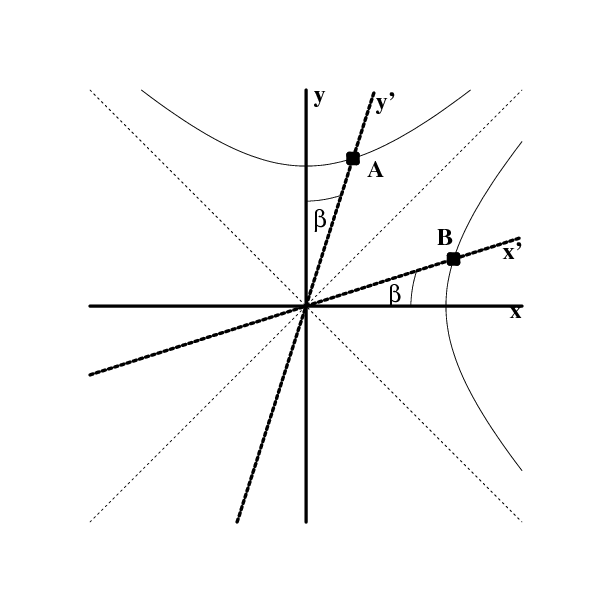- §1. Trigonometry
- §2. Distance
- §3. Triangle Trig
- §4. Rotations
- §5. Projections
- §6. Addition Formulas
Distance
We saw in the last chapter that Euclidean trigonometry is based on the circles, sets of points which are a constant distance from the origin. Hyperbola geometry is obtained simply by using a different distance function! Measure the “squared distance” of a point $B=(x,\yy)$ from the origin using the definition \begin{equation} \rho^2 = x^2 - \ysq \label{squared} \end{equation} Then “circles” of constant distance from the origin become hyperbolas with $\rho=\hbox{constant}$, and we further restrict ourselves to the branch with $x>0$. If $B$ is a point on this hyperbola, then we can define the hyperbolic angle $\beta$ between the line from the origin to $B$ and the (positive) $x$-axis to be the ratio of the Lorentzian length 1) of the arc of the hyperbola between $B$ and the point $(\rho,0)$ to the “radius” $\rho$. We could then define the hyperbolic trig functions in terms of the coordinates $(x,\yy)$ of $B$, that is \begin{eqnarray} \cosh\beta &=& \frac{x}{\rho} \label{coshdef2}\\ \end{eqnarray}\begin{eqnarray} \sinh\beta &=& \frac{\yy}{\rho} \label{sinhdef2} \end{eqnarray} and a little work shows that this definition is equivalent to the one above. 2) This construction is shown in Figure 4.2. which also shows another hyperbola, given by $x^2 - \ysq = -\rho^2$. By symmetry, the point $A$ on this hyperbola has coordinates $(x,\yy) = (\rho\,\sinh\beta, \rho\,\cosh\beta)$. We will discuss the importance of this hyperbola later.
 Figure 4.2: Defining the hyperbolic trigonometric functions via a hyperbola. The
point $A$ has coordinates $(\rho\,\sinh\beta,\rho\,\cosh\beta)$, while $B$ has coordinates $(\rho\,\cosh\beta,\rho\,\sinh\beta)$, where $\rho$ is the hyperbolic radius.
Figure 4.2: Defining the hyperbolic trigonometric functions via a hyperbola. The
point $A$ has coordinates $(\rho\,\sinh\beta,\rho\,\cosh\beta)$, while $B$ has coordinates $(\rho\,\cosh\beta,\rho\,\sinh\beta)$, where $\rho$ is the hyperbolic radius.
Many of the features of the graphs shown in Figure 4.1 follow immediately from this definition of the hyperbolic trigonometric functions in terms of coordinates along this hyperbola. Since the minimum value of $x$ on this hyperbola is $\rho$, we must have $\cosh\beta\ge1$. As $\beta$ approaches $\pm\infty$, $x$ approaches $\infty$ and $y$ approaches $\pm\infty$, which agrees with the asymptotic behavior of the graphs of $\cosh\beta$ and $\sinh\beta$, respectively. Finally, since the hyperbola has asymptotes $y=\pm x$, we see that $|\tanh\beta|<1$, and that $\tanh\beta$ must approach $\pm1$ as $\beta$ approaches $\pm\infty$.
So how do we measure the distance between two points? The “squared distance” was defined in ($\ref{squared}$), and can be positive, negative, or zero! We adopt the following convention: Take the square root of the absolute value of the “squared distance”. As we will see in the next chapter, it will also be important to remember whether the “squared distance” was positive or negative, but this corresponds directly to whether the distance is “mostly horizontal” or “mostly vertical”.